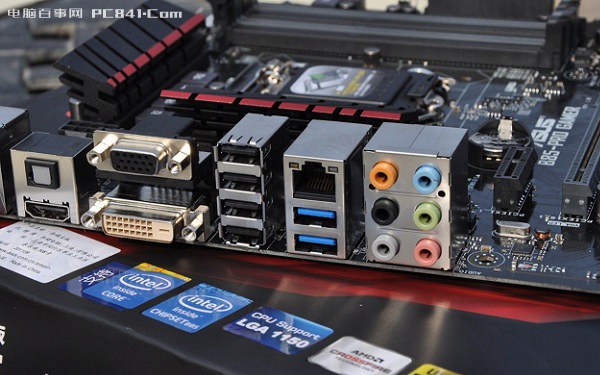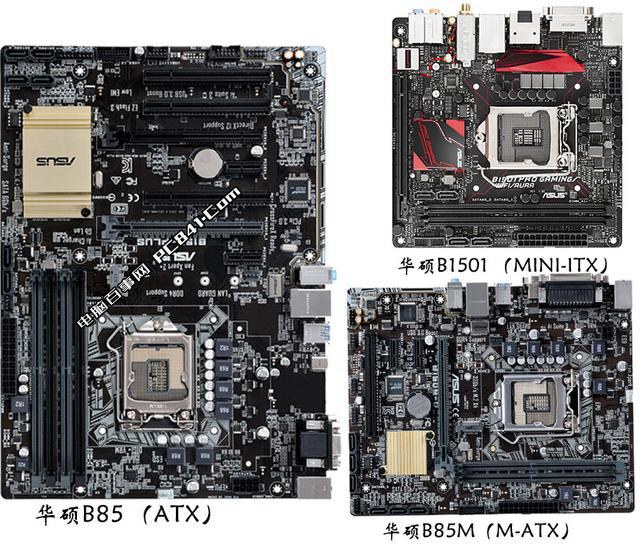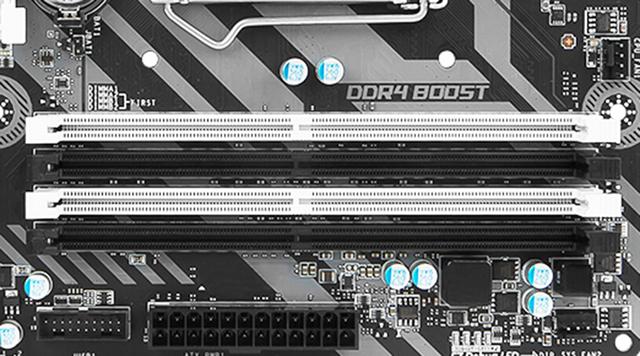Heading to the computer mall to install a machine only to get scammed by a profiteer? How do you start putting everything together yourself? Ask a friend for help but worry about not being professional enough? As they say, I’ll figure it out myself or study it thoroughly before starting.
 When it comes to the three major components that many people consider most crucial—CPU, graphics card, and memory—the motherboard often gets overlooked. Yet, it’s the foundation that supports all of these components. A well-suited motherboard is an essential part of any build. So, what should you keep in mind when purchasing a motherboard? Here are some popular knowledge points for selecting one. Hopefully, this will help you avoid being duped by profiteers and steer you toward becoming a more confident DIY builder.
**First, the motherboard form factor**
There are numerous types of computer motherboards. To simplify things for beginners, I’ll focus on the most common ones: ATX (large motherboard), Micro-ATX (mid-sized motherboard), and Mini-ITX (small motherboard).
The ATX motherboard is sturdy and luxurious, making it the top choice for high-end builds. The Micro-ATX motherboard is smaller and more affordable, currently the most popular type. The Mini-ITX motherboard is primarily used for compact PCs. Here's a comparison:
When it comes to the three major components that many people consider most crucial—CPU, graphics card, and memory—the motherboard often gets overlooked. Yet, it’s the foundation that supports all of these components. A well-suited motherboard is an essential part of any build. So, what should you keep in mind when purchasing a motherboard? Here are some popular knowledge points for selecting one. Hopefully, this will help you avoid being duped by profiteers and steer you toward becoming a more confident DIY builder.
**First, the motherboard form factor**
There are numerous types of computer motherboards. To simplify things for beginners, I’ll focus on the most common ones: ATX (large motherboard), Micro-ATX (mid-sized motherboard), and Mini-ITX (small motherboard).
The ATX motherboard is sturdy and luxurious, making it the top choice for high-end builds. The Micro-ATX motherboard is smaller and more affordable, currently the most popular type. The Mini-ITX motherboard is primarily used for compact PCs. Here's a comparison:
 **Second, the CPU socket**
Today, mainstream CPUs are divided between AMD (often referred to as "AM4") and Intel. Motherboard CPU sockets are mainly designed around these two brands. When buying a motherboard, ensure compatibility with your chosen CPU. Not all CPU sockets are the same; mismatches can render the system unusable. Research compatibility before purchasing.
Related link: How to match CPU and motherboard? About CPU and motherboard compatibility and shopping strategies.
**Third, the memory slots**
Currently, there are four main types of memory slots on the market. When purchasing, check if you plan to install multiple memory modules to create a dual-channel setup or if you want room for future upgrades. For dual-channel setups, always use the same brand of memory and insert them into the same-colored memory slots to avoid potential incompatibility issues down the line.
**Second, the CPU socket**
Today, mainstream CPUs are divided between AMD (often referred to as "AM4") and Intel. Motherboard CPU sockets are mainly designed around these two brands. When buying a motherboard, ensure compatibility with your chosen CPU. Not all CPU sockets are the same; mismatches can render the system unusable. Research compatibility before purchasing.
Related link: How to match CPU and motherboard? About CPU and motherboard compatibility and shopping strategies.
**Third, the memory slots**
Currently, there are four main types of memory slots on the market. When purchasing, check if you plan to install multiple memory modules to create a dual-channel setup or if you want room for future upgrades. For dual-channel setups, always use the same brand of memory and insert them into the same-colored memory slots to avoid potential incompatibility issues down the line.
 In addition to these key points, here are three more things to keep in mind:
**Fourth, the number of PCIe slots**
Ensure the motherboard has enough PCIe slots to accommodate your expansion needs, such as adding additional graphics cards or storage controllers.
**Fifth, power supply design**
A good motherboard should have a solid power delivery system. This ensures stable performance, especially when using high-performance CPUs or GPUs.
**Sixth, BIOS updates and features**
Check if the motherboard offers easy BIOS updates and useful features like overclocking support, RGB lighting control, and advanced network options.
Remember, building a PC is a learning experience. Don’t hesitate to dive in, experiment, and improve over time. Happy building!
In addition to these key points, here are three more things to keep in mind:
**Fourth, the number of PCIe slots**
Ensure the motherboard has enough PCIe slots to accommodate your expansion needs, such as adding additional graphics cards or storage controllers.
**Fifth, power supply design**
A good motherboard should have a solid power delivery system. This ensures stable performance, especially when using high-performance CPUs or GPUs.
**Sixth, BIOS updates and features**
Check if the motherboard offers easy BIOS updates and useful features like overclocking support, RGB lighting control, and advanced network options.
Remember, building a PC is a learning experience. Don’t hesitate to dive in, experiment, and improve over time. Happy building!
 When it comes to the three major components that many people consider most crucial—CPU, graphics card, and memory—the motherboard often gets overlooked. Yet, it’s the foundation that supports all of these components. A well-suited motherboard is an essential part of any build. So, what should you keep in mind when purchasing a motherboard? Here are some popular knowledge points for selecting one. Hopefully, this will help you avoid being duped by profiteers and steer you toward becoming a more confident DIY builder.
**First, the motherboard form factor**
There are numerous types of computer motherboards. To simplify things for beginners, I’ll focus on the most common ones: ATX (large motherboard), Micro-ATX (mid-sized motherboard), and Mini-ITX (small motherboard).
The ATX motherboard is sturdy and luxurious, making it the top choice for high-end builds. The Micro-ATX motherboard is smaller and more affordable, currently the most popular type. The Mini-ITX motherboard is primarily used for compact PCs. Here's a comparison:
When it comes to the three major components that many people consider most crucial—CPU, graphics card, and memory—the motherboard often gets overlooked. Yet, it’s the foundation that supports all of these components. A well-suited motherboard is an essential part of any build. So, what should you keep in mind when purchasing a motherboard? Here are some popular knowledge points for selecting one. Hopefully, this will help you avoid being duped by profiteers and steer you toward becoming a more confident DIY builder.
**First, the motherboard form factor**
There are numerous types of computer motherboards. To simplify things for beginners, I’ll focus on the most common ones: ATX (large motherboard), Micro-ATX (mid-sized motherboard), and Mini-ITX (small motherboard).
The ATX motherboard is sturdy and luxurious, making it the top choice for high-end builds. The Micro-ATX motherboard is smaller and more affordable, currently the most popular type. The Mini-ITX motherboard is primarily used for compact PCs. Here's a comparison:
 **Second, the CPU socket**
Today, mainstream CPUs are divided between AMD (often referred to as "AM4") and Intel. Motherboard CPU sockets are mainly designed around these two brands. When buying a motherboard, ensure compatibility with your chosen CPU. Not all CPU sockets are the same; mismatches can render the system unusable. Research compatibility before purchasing.
Related link: How to match CPU and motherboard? About CPU and motherboard compatibility and shopping strategies.
**Third, the memory slots**
Currently, there are four main types of memory slots on the market. When purchasing, check if you plan to install multiple memory modules to create a dual-channel setup or if you want room for future upgrades. For dual-channel setups, always use the same brand of memory and insert them into the same-colored memory slots to avoid potential incompatibility issues down the line.
**Second, the CPU socket**
Today, mainstream CPUs are divided between AMD (often referred to as "AM4") and Intel. Motherboard CPU sockets are mainly designed around these two brands. When buying a motherboard, ensure compatibility with your chosen CPU. Not all CPU sockets are the same; mismatches can render the system unusable. Research compatibility before purchasing.
Related link: How to match CPU and motherboard? About CPU and motherboard compatibility and shopping strategies.
**Third, the memory slots**
Currently, there are four main types of memory slots on the market. When purchasing, check if you plan to install multiple memory modules to create a dual-channel setup or if you want room for future upgrades. For dual-channel setups, always use the same brand of memory and insert them into the same-colored memory slots to avoid potential incompatibility issues down the line.
 In addition to these key points, here are three more things to keep in mind:
**Fourth, the number of PCIe slots**
Ensure the motherboard has enough PCIe slots to accommodate your expansion needs, such as adding additional graphics cards or storage controllers.
**Fifth, power supply design**
A good motherboard should have a solid power delivery system. This ensures stable performance, especially when using high-performance CPUs or GPUs.
**Sixth, BIOS updates and features**
Check if the motherboard offers easy BIOS updates and useful features like overclocking support, RGB lighting control, and advanced network options.
Remember, building a PC is a learning experience. Don’t hesitate to dive in, experiment, and improve over time. Happy building!
In addition to these key points, here are three more things to keep in mind:
**Fourth, the number of PCIe slots**
Ensure the motherboard has enough PCIe slots to accommodate your expansion needs, such as adding additional graphics cards or storage controllers.
**Fifth, power supply design**
A good motherboard should have a solid power delivery system. This ensures stable performance, especially when using high-performance CPUs or GPUs.
**Sixth, BIOS updates and features**
Check if the motherboard offers easy BIOS updates and useful features like overclocking support, RGB lighting control, and advanced network options.
Remember, building a PC is a learning experience. Don’t hesitate to dive in, experiment, and improve over time. Happy building!Zooke Connectors Co., Ltd. , https://www.zooke.com